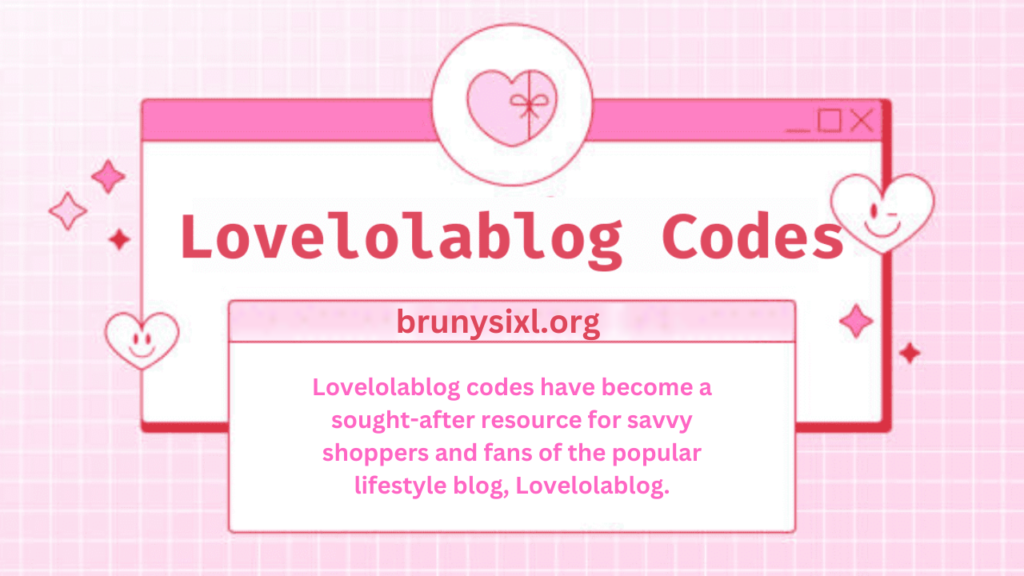Introduction to Lovelolablog Codes
Lovelolablog codes represent a unique set of tools designed to enhance the functionality and aesthetics of a blog. These codes are primarily utilized for customizing various elements of a blog, allowing creators to engage their audience more effectively through improved visual appeal and interactivity. They cater to both novice and experienced bloggers, simplifying complex coding tasks while offering flexibility in design and layout.
The significance of Lovelolablog codes in blog creation cannot be overstated. In a crowded digital landscape, where numerous blogs compete for audience attention, leveraging these codes can set a blog apart. By integrating Lovelolablog codes, writers can customize fonts, colors, buttons, and layouts to create a distinct identity. This not only attracts visitors but also fosters a sense of professionalism and attention to detail that enhances user experience.
Moreover, Lovelolablog codes emphasize the importance of reader engagement. By implementing interactive elements such as comment sections, social media sharing buttons, and responsive design features, these codes help in creating a more inviting platform for communication and discussion. Engaged readers are more likely to share content, return for future visits, and develop a connection with the blog, ultimately contributing to its growth and visibility.
As we proceed through this blog post, we will delve deeper into the various functionalities of Lovelolablog codes, their applications, and how they can be harnessed to not only create visually stunning blogs but also to foster a vibrant community of readers. The unique characteristics of Lovelolablog codes play a crucial role in shaping the blogging experience, making them an essential topic for any content creator aiming to improve their online presence.
How to Implement Lovelolablog Codes
Implementing Lovelolablog codes into your blogging platform can significantly enhance your content and interaction with readers. This guide will provide you with detailed instructions to integrate these codes effectively, ensuring a smoother blogging experience. Here’s how to get started.
First, you will need to access your blog’s code editor. Depending on your blogging platform, this may be located under settings or a specific section labeled “HTML” or “Template.” Before making any changes, it is advisable to back up your existing template to prevent loss of data. Once you have access, you can begin to implement the Lovelolablog codes.
To integrate a specific Lovelolablog code, locate the section of your code where you want the feature to appear. Copy the desired code snippet from the Lovelolablog resources and paste it into the appropriate area of your blog’s code. Be sure to place it within appropriate HTML tags, such as <div> or <section>, to maintain proper structure.
For beginners, it may be helpful to refer to detailed tutorials that align with your specific blogging platform, as the process may vary. Additionally, a great tip is to preview changes before publishing. This will allow you to identify any issues without affecting the live site. Pay attention to spacing, formatting, and functionality to ensure that the integration appears as intended.
Common pitfalls to avoid include neglecting to validate your code changes, which could lead to broken links or layout issues. Furthermore, ensure that plugins or additional codes you implement do not conflict with existing ones. By following these detailed steps and tips, you can efficiently implement Lovelolablog codes to enrich your blog’s functionality and aesthetics.
Creative Uses of Lovelolablog Codes
The integration of lovelolablog codes into blogging practices can vastly enhance the overall user experience and engagement, unlocking new levels of creativity. Bloggers can utilize these codes in various innovative ways that not only enrich their content but also set their posts apart from the vast sea of online writing.
One remarkable application of lovelolablog codes is the creation of interactive elements within blog posts. For instance, a travel blogger may implement these codes to design an interactive map, allowing readers to explore different destinations referenced in their articles. This not only engages the audience dynamically but also provides them with a more immersive way to connect with the content.

Furthermore, customization of layouts through the application of lovelolablog codes opens up numerous design possibilities. A food blogger could create visually appealing recipe cards that not only organize ingredients and steps but also incorporate mouth-watering imagery. This kind of tailored presentation not only promotes aesthetic appeal but also enhances readability, making it easier for followers to navigate the recipes.
Enhancing user engagement through quizzes or polls is another effective strategy enabled by lovelolablog codes. For example, an educational blog might use these codes to install a quiz at the end of a post, allowing readers to test their knowledge on the topic discussed. This interactivity not only heightens user participation but also encourages visitors to share their results, thereby increasing the blog’s visibility.
Additionally, integrating multimedia elements such as videos or slideshows can be accomplished through innovative lovelolablog codes. For instance, a blogger chronicling a DIY project can enrich their narrative by embedding a time-lapse video of the project’s progression, providing viewers with both insight and inspiration.
These examples illustrate just a few of the creative avenues available through lovelolablog codes, encouraging bloggers to think outside conventional frameworks and embrace personalized formats that resonate with their audience. By employing these suggestions, bloggers can effectively elevate their content and engage with their readers in a more dynamic way.
Troubleshooting Common Issues with Lovelolablog Codes
In the process of utilizing Lovelolablog codes, users may encounter various challenges that can hinder their blogging experience. Addressing these common issues effectively is crucial for enhancing the overall performance of their blogs. One frequent problem involves incorrect code implementation, which can lead to unexpected behaviors on the site. For instance, misplaced tags or syntax errors can result in formatting issues or even rendering the page unreadable. Therefore, a meticulous review of the code is essential, ensuring that it aligns with the recommended guidelines.
Another common error is related to compatibility with plugins or themes. Some Lovelolablog codes may not function optimally with certain WordPress themes or third-party plugins, causing conflicts that can disrupt site functionality. It is advisable to check the documentation of both the Lovelolablog codes and the theme or plugin in use to determine compatibility, as well as keeping everything updated to their latest versions.
Users often face performance issues as well, particularly when using multiple Lovelolablog codes simultaneously. The cumulative effect of running several scripts can result in slow loading times or a lag in site responsiveness. To troubleshoot this, it is beneficial to adopt a modular approach. By enabling and disabling codes incrementally, one can identify which specific code is causing the performance degradation. Furthermore, utilizing performance analysis tools can provide insights and metrics that aid in diagnosing these issues.
Lastly, connection problems may arise when integrating external services using Lovelolablog codes. Issues such as API rate limits or server downtimes may disrupt the expected performance. Monitoring the status of these services, coupled with implementing error-handling mechanisms in the code, will ensure that these external dependencies do not negatively impact the user experience.
In conclusion, understanding how to troubleshoot common problems associated with Lovelolablog codes is vital for maintaining an efficient and effective blogging platform. By identifying and addressing these issues promptly, bloggers can enjoy a smoother experience and maximize the potential of their blogging endeavors.
buryfairy.fun megablend.fun quirkyvault.fun buzzchamber.fun infogalaxy.fun gigatwist.fun usatechhub.com famousparenting.site itbetterthisworld.fun worldblogist.fun popularsmedia.fun portalnewsletter.fun mluczak.pro techx.click trendroar.space thinkmash.space byteorbit.space blinknest.fun minglehive.fun rifflezone.fun buzzosaur.fun epicsphere.fun gamebrew.fun vortexplays.fun happagappa.com feedviber.com fintechzoomus.blog techmag.site stackloft.blog globalmagzine.news DailyLaughs.fun FunFairy.fun PlayFusion.space LootLagoon.space Scrollcrunch.space whatisxovfullmins.com Abouthizzaboloufazic.com aboutkiolopobgofit.com
Life is a continuous journey filled with unexpected moments that shape our character and influence the path we take. Each day presents new opportunities to learn, connect with others, and face challenges that test our resilience. These experiences, whether positive or difficult, help us grow stronger and wiser over time. Embracing change instead of resisting it allows
